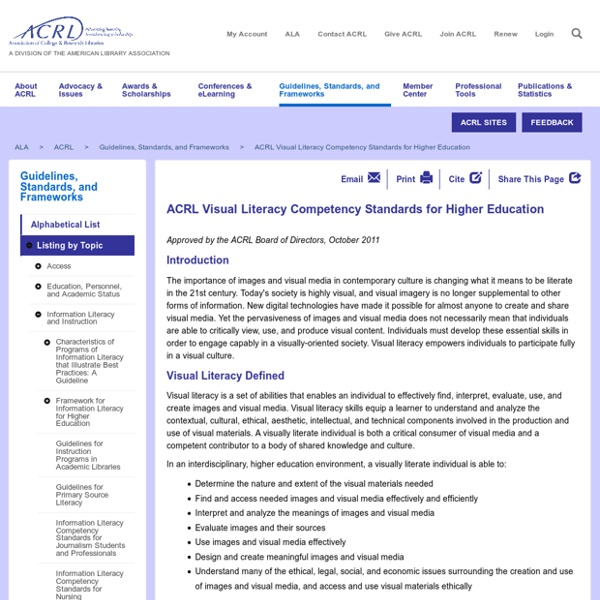ACRL Visual Literacy Competency Standards for Higher Education

PowerPoint Tutorials
With as many PowerPoint questions that I get, it’s a good thing that over the past year or so the elearning community has created about 300 PowerPoint tutorials. For this post, I decided to pull a bunch of them together so that you have them in one easy list. I also included a free PowerPoint elearning template to celebrate the holidays and a great 2010! Click to download the free PowerPoint template. 100+ PowerPoint Tutorials If you want to learn more about using PowerPoint or building rapid elearning courses, this list is a good place to start. I loosely organized the tutorials by topic so they’re a little easier to scan. PowerPoint for Rapid E-Learning PowerPoint Tips for Graphic Design Create Illustrations & Objects in PowerPoint Animation Tips & Tricks in PowerPoint How to Use PowerPoint Tutorials PowerPoint Resources People to follow on Screenr There are many people on Screenr who create useful PowerPoint and rapid elearning tutorials. I hope you have a Happy New Year! Tidbits
Back to the Story Spine | Aerogramme Writers' StudioBack to the Story Spine
I created the Story Spine in 1991 and, over the years, I’ve been thrilled to watch more and more people use it, teach it, discuss it, and even modify it in order to make it their own. One of my favorite modifications is the addition of “And, the moral of the story is…” at the very end. Over time, however, some of its permutations have become less powerful, I think, than the original due to a missing link here or a different word there. So, I’m happy to present it here in its original 8-line format along with a brief analysis, a couple of interesting examples, and some tips on how to best make use of it. To see how it works, let’s find the Story Spine in two famous movies: The Incredibles Once upon a time there was a superhero named Mr. Every day, he grew more and more frustrated with his stifling, boring life. But one day, he accepted a secret superhero job from a mysterious stranger. Because of that, Syndrome was able to capture and imprison Mr. Until finally, Mr. The Wizard of Oz
Attribution CC Wiki
You can use CC-licensed materials as long as you follow the license conditions. One condition of all CC licenses is attribution. Here are some good (and not so good) examples of attribution. Note: If you want to learn how to mark your own material with a CC license go here. Examples of attribution Here is a photo. This is an ideal attribution Because: Title? Author? Source? License? This is a pretty good attribution Title? Author? Source? License? This is an incorrect attribution Photo: Creative Commons Title? Author? Source? License? This is a good attribution for material you modified slightly Title, Author, Source, and License are all noted Modification? This is a good attribution for material from which you created a derivative work Original Title, Author, Source, and License are all noted Derivative? New author of the derivative work is also noted Note: If you're at a point where you are licensing derivative works, go to Marking your work with a CC license. Title? Author? Source? License? 1.
Royalty Free Music | Stock Music - IB Audio
Best Practices
MISCELLANEOUS RESOURCES
Related:
Related:



